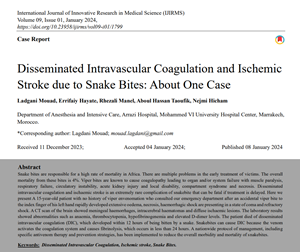Disseminated Intravascular Coagulation and Ischemic Stroke due to Snake Bites: About One Case
Main Article Content
Abstract
Snake bites are responsible for a high rate of mortality in Africa. There are multiple problems in the early treatment of victims. The overall mortality from these bites is 4%. Viper bites are known to cause coagulopathy leading to organ and/or system failure with muscle paralysis, respiratory failure, circulatory instability, acute kidney injury and local disability, compartment syndrome and necrosis. Disseminated intravascular coagulation and ischaemic stroke is an extremely rare complication of snakebite that can be fatal if treatment is delayed. Here we present A 15-year-old patient with no history of viper envenomation who consulted our emergency department after an accidental viper bite to the index finger of his left hand rapidly developed extensive oedema, necrosis, haemorrhagic shock are presenting in a state of coma and refractory shock. A CT scan of the brain showed meningeal haemorrhages, intracerebral haematomas and diffuse ischaemic lesions. The laboratory results showed abnormalities such as anaemia, thrombocytopenia, hypofibrinogenemia and elevated D-dimer levels. The patient died of disseminated intravascular coagulation (DIC), which developed within 12 hours of being bitten by a snake. Snakebites can cause DIC because the venom activates the coagulation system and causes fibrinolysis, which occurs in less than 24 hours. A nationwide protocol of management, including specific antivenom therapy and prevention strategies, has been implemented to reduce the overall morbidity and mortality of snakebites.
Article Details

This work is licensed under a Creative Commons Attribution 4.0 International License.
